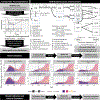State-level needs for social distancing and contact tracing to contain COVID-19 in the United States
- PMID: 33024280
- PMCID: PMC7572893
- DOI: 10.1038/s41562-020-00969-7
State-level needs for social distancing and contact tracing to contain COVID-19 in the United States
Abstract
Starting in mid-May 2020, many US states began relaxing social-distancing measures that were put in place to mitigate the spread of COVID-19. To evaluate the impact of relaxation of restrictions on COVID-19 dynamics and control, we developed a transmission dynamic model and calibrated it to US state-level COVID-19 cases and deaths. We used this model to evaluate the impact of social distancing, testing and contact tracing on the COVID-19 epidemic in each state. As of 22 July 2020, we found that only three states were on track to curtail their epidemic curve. Thirty-nine states and the District of Columbia may have to double their testing and/or tracing rates and/or rolling back reopening by 25%, while eight states require an even greater measure of combined testing, tracing and distancing. Increased testing and contact-tracing capacity is paramount for mitigating the recent large-scale increases in US cases and deaths.
Conflict of interest statement
Competing interests
The authors declare no competing interests.
Figures









Update of
-
State-level needs for social distancing and contact tracing to contain COVID-19 in the United States.Res Sq [Preprint]. 2020 Sep 16:rs.3.rs-40364. doi: 10.21203/rs.3.rs-40364/v2. Res Sq. 2020. Update in: Nat Hum Behav. 2020 Oct;4(10):1080-1090. doi: 10.1038/s41562-020-00969-7. PMID: 32702727 Free PMC article. Updated. Preprint.
References
-
- Johns Hopkins Coronavirus Resource Center. Available at: https://coronavirus.jhu.edu/. (Accessed: 18th May 2020)
-
- Wu Z & McGoogan JM Characteristics of and Important Lessons from the Coronavirus Disease 2019 (COVID-19) Outbreak in China: Summary of a Report of 72314 Cases from the Chinese Center for Disease Control and Prevention. JAMA - Journal of the American Medical Association 323, 1239–1242 (2020). - PubMed
Publication types
MeSH terms
Grants and funding
LinkOut - more resources
Full Text Sources
Medical
Research Materials

